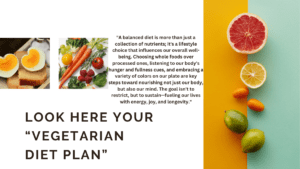# Vegetarian Diet Plan:
# Introduction
A vegetarian diet plan is one of the most popular and enduring dietary choices globally, embraced for its numerous health benefits, ethical considerations, and environmental impact.
By excluding meat, poultry, and fish, a vegetarian diet primarily focuses on plant-based foods, which are rich in essential nutrients and can support overall well-being. In this article, we will delve deep into the vegetarian diet plan, exploring its benefits, nutritional considerations, and a detailed daily meal plan to help you get started or refine your existing vegetarian lifestyle.

# Chapter 1: Understanding the Vegetarian Diet Plan:
# 1.1 What is a Vegetarian Diet?
A vegetarian diet is centered around plant-based foods and excludes all forms of meat, including red meat, poultry, fish, and other seafood. However, there are various types of vegetarian diets, each with different inclusions and exclusions:
– *Lacto-Vegetarian:* Includes dairy products but excludes eggs.
– *Ovo-Vegetarian:* Includes eggs but excludes dairy products.
– *Lacto-Ovo Vegetarian:* Includes both dairy products and eggs.
– *Vegan:* Excludes all animal products, including dairy, eggs, and honey.
Each of these diets can offer different benefits and challenges, depending on personal preferences, ethical beliefs, and nutritional needs.
# 1.2 The Rise of Vegetarianism
The popularity of vegetarianism has been on the rise in recent years, driven by increasing awareness of health benefits, environmental concerns, and animal welfare.
Studies have shown that a vegetarian diet can reduce the risk of chronic diseases such as heart disease, type 2 diabetes, and certain cancers. Additionally, a plant-based diet is generally more sustainable, requiring fewer resources and producing lower greenhouse gas emissions compared to meat-based diets.
# 1.3 Health Benefits of a Vegetarian Diet
The vegetarian diet is associated with a variety of health benefits, including:
– *Heart Health:* A diet rich in fruits, vegetables, whole grains, and legumes can lower cholesterol levels and reduce blood pressure, decreasing the risk of heart disease.
– *Weight Management:* Vegetarian diets are often lower in calories and high in fiber, helping with weight control and preventing obesity.
– *Diabetes Prevention:* Plant-based diets can improve insulin sensitivity and lower the risk of developing type 2 diabetes.
– *Cancer Prevention:* A diet high in fruits, vegetables, and whole grains is linked to a reduced risk of certain cancers, such as colorectal cancer.
– *Longevity:* Studies suggest that vegetarians may live longer due to their lower risk of chronic diseases.
# Best Electric Cars in India 2024 : look some cars according your budget.
# Chapter 2: Nutritional Considerations Vegetarian Diet Plan:
# 2.1 Key Nutrients in a Vegetarian Diet
While a vegetarian diet can be highly nutritious, it’s important to pay attention to certain nutrients that may be less abundant in plant-based foods:
– *Protein:* Essential for muscle repair and growth, protein can be found in beans, lentils, tofu, tempeh, nuts, seeds, and dairy products.
– *Iron:* Crucial for oxygen transport in the body, iron is found in spinach, lentils, beans, fortified cereals, and pumpkin seeds. Consuming vitamin C-rich foods alongside iron-rich foods can enhance iron absorption.
– *Calcium:* Important for bone health, calcium can be obtained from dairy products, fortified plant-based milks, tofu, and leafy greens like kale and bok choy.
– *Vitamin B12:* Necessary for nerve function and the production of red blood cells, vitamin B12 is primarily found in animal products. Vegetarians should consider fortified foods or supplements.
– *Omega-3 Fatty Acids:* Essential for heart and brain health, omega-3s can be sourced from flaxseeds, chia seeds, walnuts, and algae-based supplements.
– *Vitamin D:* Important for bone health and immune function, vitamin D can be obtained from sunlight exposure, fortified foods, and supplements.
# 2.2 Balancing Macronutrients
A well-balanced vegetarian diet should include an appropriate balance of macronutrients: carbohydrates, proteins, and fats.
– *Carbohydrates:* Focus on complex carbohydrates from whole grains, fruits, and vegetables. These provide sustained energy and essential fiber for digestive health.
– *Proteins:* Include a variety of protein sources to ensure a complete amino acid profile. Combining different plant-based proteins, such as beans and rice, can help achieve this.
– *Fats:* Prioritize healthy fats from sources like avocados, nuts, seeds, and olive oil. These fats support brain health, hormone production, and nutrient absorption.
# Chapter 3: Building a Vegetarian Meal Plan
# 3.1 Breakfast Ideas
A nutritious breakfast sets the tone for the day, providing energy and essential nutrients. Here are some vegetarian breakfast options:
– *Overnight Oats:* Combine rolled oats with almond milk, chia seeds, and fresh fruits. Leave it in the fridge overnight, and enjoy a quick, nutrient-packed breakfast in the morning.
– *Smoothie Bowl:* Blend frozen berries, spinach, a banana, and a scoop of protein powder. Top with granola, nuts, and seeds for added crunch and nutrients.
– *Avocado Toast:* Spread mashed avocado on whole-grain toast, and top with cherry tomatoes, a sprinkle of salt, and a drizzle of olive oil. Add a poached egg for extra protein.
– *Vegetable Omelette:* Whisk eggs with chopped vegetables like bell peppers, onions, and spinach. Cook in a non-stick pan with a little olive oil for a protein-rich start to your day.
– *Chia Pudding:* Mix chia seeds with coconut milk and a touch of honey. Let it sit overnight, and enjoy with fresh fruit and a sprinkle of nuts in the morning.
# 3.2 Lunch Ideas
Lunch should be a balanced meal that keeps you satisfied and energized throughout the afternoon. Consider these vegetarian lunch options:
– *Quinoa Salad:* Toss cooked quinoa with chickpeas, cucumber, cherry tomatoes, feta cheese, and a lemon-tahini dressing for a refreshing and protein-packed salad.
– *Veggie Stir-Fry:* Sauté a mix of your favorite vegetables, such as broccoli, bell peppers, and snap peas, in a soy-ginger sauce. Serve over brown rice or noodles for a satisfying meal.
– *Grain Bowl:* Start with a base of brown rice, farro, or barley, and top with roasted vegetables, a boiled egg, avocado, and a drizzle of tahini or yogurt dressing.
– *Stuffed Pita:* Fill a whole-wheat pita with hummus, falafel, shredded lettuce, and sliced cucumbers. Add a side of tzatziki sauce for a Mediterranean-inspired lunch.
– *Caprese Sandwich:* Layer fresh mozzarella, sliced tomatoes, and basil leaves on a whole-grain baguette. Drizzle with balsamic glaze and olive oil for a simple yet flavorful sandwich.
# 3.3 Dinner Ideas
Dinner is the perfect opportunity to enjoy a hearty and fulfilling vegetarian meal. Here are some ideas to inspire your evening meals:
– *Vegetable Curry:* Cook a variety of vegetables, such as cauliflower, sweet potatoes, and spinach, in a coconut milk-based curry sauce. Serve with basmati rice or naan bread.
– *Lentil Soup:* Simmer lentils with carrots, celery, onions, and garlic in a vegetable broth. Season with herbs like thyme and bay leaves for a comforting and nutritious soup.
– *Stuffed Bell Peppers:* Fill bell peppers with a mixture of quinoa, black beans, corn, and cheese. Bake until the peppers are tender and the cheese is melted and golden.
– *Eggplant Parmesan:* Layer slices of breaded and baked eggplant with marinara sauce and mozzarella cheese. Bake until bubbly, and serve with a side of whole-grain pasta.
– *Veggie Tacos:* Fill soft corn tortillas with roasted vegetables, black beans, avocado, and salsa. Top with a sprinkle of cheese and a squeeze of lime for a delicious and easy dinner.
# 3.4 Snacks and Desserts
Snacking is an important part of a vegetarian diet, helping to maintain energy levels between meals. Here are some healthy snack and dessert options:
– *Greek Yogurt with Berries:* A bowl of Greek yogurt topped with fresh berries and a drizzle of honey makes for a protein-rich snack or light dessert.
– *Nut Butter with Apple Slices:* Slice an apple and dip it in almond or peanut butter for a satisfying snack that combines healthy fats and fiber.
– *Hummus and Veggies:* Enjoy a plate of sliced cucumbers, carrots, and bell peppers with a side of hummus for a crunchy and nutrient-dense snack.
– *Dark Chocolate:* A small piece of dark chocolate can satisfy your sweet tooth while providing antioxidants and a rich flavor.
– *Energy Balls:* Mix oats, nut butter, honey, and dried fruits to form bite-sized energy balls. Store them in the fridge for a quick and portable snack.
# Chapter 4: Vegetarian Diet for Specific Goals
# 4.1 Weight Loss
A vegetarian diet can be effective for weight loss when properly planned. To achieve your weight loss goals, focus on the following:
– *Calorie Control:* Monitor portion sizes and avoid high-calorie, processed vegetarian foods.
– *Fiber Intake:* Increase your intake of high-fiber foods like vegetables, fruits, and whole grains to keep you full for longer.
– *Protein:* Ensure you’re getting enough protein from plant-based sources to support muscle mass and metabolism.
– *Meal Timing:* Eat regular meals and snacks to avoid overeating later in the day.
Sample Weight Loss Meal Plan:
– *Breakfast:* Smoothie with spinach, banana, protein powder, and almond milk.
– *Lunch:* Quinoa salad with chickpeas, cucumber, and a lemon-tahini dressing.
– *Snack:* Apple slices with almond butter.
– *Dinner:* Veggie stir-fry with tofu and brown rice.
– *Dessert:* A small piece of dark chocolate.
– *Hydration:* Drink plenty of water throughout the day to stay hydrated and help control hunger. Sometimes thirst is mistaken for hunger, leading to unnecessary snacking.
– *Exercise:* Combine your vegetarian diet with regular physical activity. Exercise helps burn calories, build muscle, and improve overall fitness, supporting your weight loss efforts.
# 4.2 Building Muscle on a Vegetarian Diet
Building muscle on a vegetarian diet is entirely possible, but it requires careful attention to protein intake and overall calorie consumption. To support muscle growth:
– *High-Protein Foods:* Incorporate a variety of high-protein plant-based foods such as tofu, tempeh, lentils, chickpeas, quinoa, and seitan. Dairy products like Greek yogurt and cottage cheese can also contribute to your protein needs if you’re not vegan.
– *Protein Timing:* Distribute your protein intake evenly throughout the day to support muscle repair and growth. Aim for protein-rich snacks between meals, such as a smoothie with protein powder or a handful of nuts.
– *Strength Training:* Engage in regular strength training exercises, such as weightlifting, resistance bands, or bodyweight exercises. These activities create the necessary stimulus for muscle growth.
– *Caloric Surplus:* Ensure you’re consuming more calories than you burn, as building muscle requires a caloric surplus. This can be achieved by adding healthy, calorie-dense foods like nuts, seeds, and avocados to your diet.
Sample Muscle-Building Meal Plan:
– *Breakfast:* Scrambled tofu with spinach, tomatoes, and whole-grain toast.
– *Lunch:* Lentil and quinoa salad with mixed greens and a tahini dressing.
– *Snack:* Protein smoothie with almond milk, banana, protein powder, and a handful of almonds.
– *Dinner:* Chickpea curry with brown rice and steamed broccoli.
– *Dessert:* Greek yogurt with honey and walnuts.
# 4.3 Vegetarian Diet plan for Athletes
Athletes following a vegetarian diet need to pay particular attention to their nutritional intake to support performance, recovery, and overall health. Key considerations for vegetarian athletes include:
– *Protein:* Ensure adequate protein intake to support muscle repair and recovery. Incorporate a variety of plant-based protein sources, and consider protein supplements if needed.
– *Carbohydrates:* Carbohydrates are the primary fuel source for athletes. Focus on complex carbs such as whole grains, fruits, and vegetables to provide sustained energy.
– *Hydration:* Stay well-hydrated, particularly during and after exercise. Include electrolyte-rich foods like bananas, coconut water, and leafy greens to maintain electrolyte balance.
– *Recovery Nutrition:* After workouts, consume a meal or snack that includes both protein and carbohydrates to aid recovery. A post-workout smoothie with protein powder, fruit, and leafy greens can be an excellent choice.
Sample Athlete Meal Plan:
– *Pre-Workout:* A banana with a tablespoon of almond butter.
– *Post-Workout:* Smoothie with protein powder, spinach, mixed berries, and oat milk.
– *Lunch:* Brown rice bowl with black beans, avocado, salsa, and a side of steamed vegetables.
– *Snack:* Trail mix with nuts, seeds, and dried fruit.
– *Dinner:* Stir-fry with tofu, mixed vegetables, and quinoa.
– *Evening Snack:* Cottage cheese with pineapple chunks.

# Chapter 5: Vegetarian Diet plan for Specific Populations
# 5.1 Vegetarian Diet for Children
A vegetarian diet can provide all the essential nutrients needed for healthy growth and development in children. However, it’s crucial to ensure that their diet is well-balanced and nutrient-dense:
– *Protein:* Include a variety of protein sources such as beans, lentils, tofu, dairy products, and eggs.
– *Calcium and Vitamin D:* Ensure adequate intake of calcium-rich foods and consider a vitamin D supplement if necessary, especially for children with limited sun exposure.
– *Iron:* Offer iron-rich foods such as beans, fortified cereals, and leafy greens. Pair these with vitamin C-rich foods like oranges or strawberries to enhance absorption.
– *Healthy Fats:* Include sources of healthy fats, such as avocados, nuts, seeds, and olive oil, to support brain development.
Sample Child-Friendly Vegetarian Meal Plan:
– *Breakfast:* Whole-grain cereal with milk and sliced banana.
– *Lunch:* Grilled cheese sandwich with a side of carrot sticks and hummus.
– *Snack:* Yogurt with mixed berries and a sprinkle of granola.
– *Dinner:* Spaghetti with marinara sauce, veggie meatballs, and steamed broccoli.
– *Dessert:* A small bowl of fruit salad.
# 5.2 Vegetarian Diet for Seniors
As we age, nutritional needs change, and seniors following a vegetarian diet should focus on the following:
– *Protein:* Maintain muscle mass by consuming protein-rich foods like eggs, dairy, legumes, and fortified plant-based products.
– *Calcium and Vitamin D:* Protect bone health with adequate calcium intake from dairy or fortified plant-based alternatives. Vitamin D supplements may also be necessary.
– *Fiber:* Increase fiber intake to support digestive health and prevent constipation. Include plenty of fruits, vegetables, whole grains, and legumes.
– *B12 and Omega-3s:* Consider fortified foods or supplements for vitamin B12 and omega-3 fatty acids, as deficiencies are more common in older adults.
Sample Senior Vegetarian Meal Plan:
– *Breakfast:* Oatmeal with almond milk, chopped nuts, and sliced apples.
– *Lunch:* Lentil soup with a side of whole-grain bread and a small salad.
– *Snack:* A smoothie with spinach, frozen berries, and fortified plant-based milk.
– *Dinner:* Baked sweet potato with black beans, steamed spinach, and a sprinkle of cheese.
– *Dessert:* A small portion of dark chocolate or a fruit yogurt.
# Chapter 6: Overcoming Challenges on a Vegetarian Diet plan
# 6.1 Common Pitfalls
While a vegetarian diet offers numerous health benefits, there are some common pitfalls to watch out for:
– *Relying on Processed Foods:* Many vegetarian-friendly processed foods are high in unhealthy fats, sugars, and sodium. Focus on whole, minimally processed foods as much as possible.
– *Nutrient Deficiencies:* Pay close attention to nutrients like vitamin B12, iron, calcium, and omega-3 fatty acids. Regular blood tests can help monitor nutrient levels.
– *Lack of Variety:* Ensure your diet includes a wide range of foods to provide all essential nutrients. Experiment with different cuisines and ingredients to keep meals interesting.
# 6.2 Social Situations
Navigating social situations as a vegetarian diet plan can be challenging, especially when attending events or dining out:
– *Plan Ahead:* If attending a gathering, consider bringing a vegetarian dish to share or check the menu in advance if dining out.
– *Communicate Your Needs:* Don’t hesitate to inform hosts or waitstaff of your dietary preferences. Most places are accommodating to vegetarians.
– *Stay Flexible:* In situations where vegetarian diet plan options are limited, focus on side dishes, salads, or request modifications to existing menu items.
# 6.3 Traveling as a Vegetarian diet plan
Traveling can pose challenges for maintaining a vegetarian diet, but with some planning, it’s entirely manageable:
– *Research Ahead:* Before traveling, research vegetarian-friendly restaurants and local dishes in your destination.
– *Pack Snacks:* Bring along portable snacks like nuts, seeds, dried fruit, and energy bars to tide you over between meals.
– *Learn Basic Phrases:* If traveling abroad, learn a few key phrases in the local language to communicate your dietary preferences.
# Chapter 7: Transitioning to a Vegetarian Diet plan
# 7.1 Gradual Transition
Transitioning to a vegetarian diet doesn’t have to happen overnight. Gradual changes can make the process easier and more sustainable:
– *Start with Meatless Days:* Begin by designating one or two days a week as meatless days, focusing on vegetarian meals.
– *Experiment with New Recipes:* Explore vegetarian recipes and experiment with new ingredients to find what you enjoy.
– *Educate Yourself:* Learn about the nutritional aspects of a vegetarian diet to ensure you’re meeting your needs.
# 7.2 Handling Cravings
Cravings for meat or other non-vegetarian foods can be a challenge, especially in the early stages of transitioning:
– *Find Alternatives:* Explore plant-based meat substitutes, which can help satisfy cravings for familiar textures and flavors.
– *Focus on Flavors:* Use herbs, spices, and sauces to enhance the flavors of vegetarian dishes, making them more appealing.
– *Stay Mindful:* Remind yourself of the reasons behind your choice to adopt a vegetarian diet, whether for health, ethical, or environmental reasons.
# Conclusion
A vegetarian diet plan can be a healthy, fulfilling, and sustainable way of eating when approached with careful planning and awareness. Whether you’re looking to improve your health, lose weight, build muscle, or simply adopt a more ethical and environmentally-friendly lifestyle, a well-balanced vegetarian diet plan can meet your needs.
By focusing on a diverse range of nutrient-dense foods and being mindful of potential nutritional gaps, you can thrive on a vegetarian diet and enjoy the many benefits it offers.
Remember, the key to long-term success on a vegetarian diet is variety, balance, and an openness to exploring new foods and flavors. With this comprehensive guide, you’re well-equipped to embark on or continue your vegetarian journey, ensuring that your diet is both delicious and nutritionally complete.
REad more us : Best Electric cars in india


